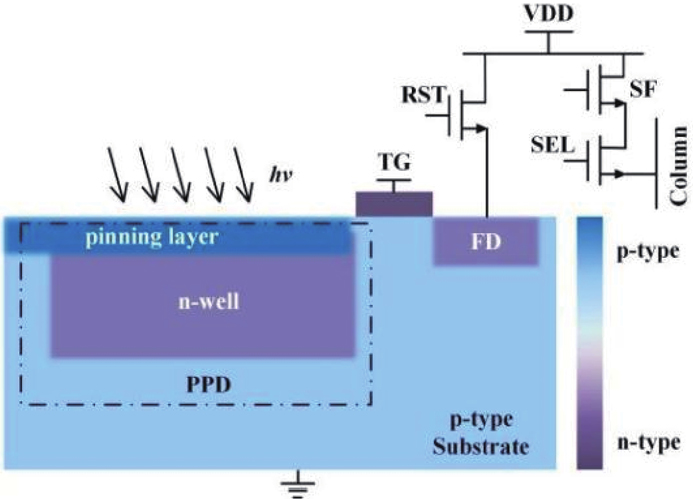
Author Affiliations
Abstract
1 Zhejiang Laboratory, Research Center for Frontier Fundamental Studies, Hangzhou, China
2 Zhejiang University, College of Optical Science and Engineering, State Key Laboratory of Extreme Photonics and Instrumentation, Hangzhou, China
3 ZJU-Hangzhou Global Scientific and Technological Innovation Center, Hangzhou, China
4 Shanghai Jiao Tong University, Chip Hub for Integrated Photonics Xplore (CHIPX), Wuxi, China
With the rapid development of sensor networks, machine vision faces the problem of storing and computing massive data. The human visual system has a very efficient information sense and computation ability, which has enlightening significance for solving the above problems in machine vision. This review aims to comprehensively summarize the latest advances in bio-inspired image sensors that can be used to improve machine-vision processing efficiency. After briefly introducing the research background, the relevant mechanisms of visual information processing in human visual systems are briefly discussed, including layer-by-layer processing, sparse coding, and neural adaptation. Subsequently, the cases and performance of image sensors corresponding to various bio-inspired mechanisms are introduced. Finally, the challenges and perspectives of implementing bio-inspired image sensors for efficient machine vision are discussed.
bio-inspired image sensor machine vision layer-by-layer processing sparse coding neural adaptation Advanced Photonics
2024, 6(2): 024001

Author Affiliations
Abstract
1 School of Electronics and Information, Hangzhou Dianzi University, Hangzhou 310018, China
2 Tianjin Key Laboratory of Imaging and Sensing Microelectronic Technology, School of Microelectronics, Tianjin University, Tianjin 300072, China
3 Chongqing Optoelectronics Research Institute, Chongqing 400060, China
CMOS image sensors produced by the existing CMOS manufacturing process usually have difficulty achieving complete charge transfer owing to the introduction of potential barriers or Si/SiO2 interface state traps in the charge transfer path, which reduces the charge transfer efficiency and image quality. Until now, scholars have only considered mechanisms that limit charge transfer from the perspectives of potential barriers and spill back effect under high illumination condition. However, the existing models have thus far ignored the charge transfer limitation due to Si/SiO2 interface state traps in the transfer gate channel, particularly under low illumination. Therefore, this paper proposes, for the first time, an analytical model for quantifying the incomplete charge transfer caused by Si/SiO2 interface state traps in the transfer gate channel under low illumination. This model can predict the variation rules of the number of untransferred charges and charge transfer efficiency when the trap energy level follows Gaussian distribution, exponential distribution and measured distribution. The model was verified with technology computer-aided design simulations, and the results showed that the simulation results exhibit the consistency with the proposed model.
CMOS image sensor charge transfer interface state traps Journal of Semiconductors
2023, 44(11): 114104
1 西安理工大学, 西安 710048
2 西安电子科技大学, 西安 710071)
为抑制像素阵列在曝光阶段的暗电流对图像传感器动态范围和输出图像质量的影响, 基于同步自适应的暗电流跟踪机制, 提出一种电路与系统级暗电流积分补偿方法。通过采样输出有效光电信号, 在无源处理阶段同步进行暗电流消除。该方法不仅可以补偿不同区域暗电流对有效光电信号的影响, 而且可解决传统暗电流消除方法对读出电路动态范围会造成衰减的问题。基于该方法, 在55 nm CMOS工艺下设计了一种752×512阵列规模的CMOS图像传感器, 实现了完整的电路设计、版图设计与后端物理验证。结果显示, 采用集成暗电流补偿技术的采样放大电路对暗电流最小补偿精度可以达到12 bit, 补偿范围最大可以达到500 mV, 单列功耗仅有1584 μW, 同时可实现1~4倍的增益, 最小增益步进625%。实现了从模拟前端根除暗电流对CMOS图像传感器图像质量和动态范围的影响, 为高端、高性能的CMOS图像传感器设计提供了一定的理论支撑。
CMOS图像传感器 暗电流补偿 同步自适应 动态范围 可编程增益放大器 CMOS image sensor dark current compensation synchronous adaptive dynamic range programmable gain amplifier (PGA)
1 厦门理工学院 光电与通信工程学院, 福建 厦门 361024
2 北京大学 电子学院 碳基电子学研究中心, 北京 100871
随着红外技术和探测器性能的进步, 中波和短波红外技术在恶劣天气中具有更优秀的成像性能, 在民用、**和航空航天等领域中得到了越来越广泛的应用。读出电路作为连接探测器阵列与后级图像处理电路的关键模块, 其性能对中短波红外相机系统性能具有重要影响, 决定了最终的成像质量。文章综述了中短波红外图像传感器读出电路的发展现状, 分析了读出电路中噪声、动态范围、帧频等问题, 重点探讨了针对以上问题的解决方案。最后对读出电路未来设计的改进方向进行了讨论。
中/短波红外 图像传感器 读出电路 动态范围 MW/SWIR image sensor ROIC dynamic range
1 云南大学 材料与能源学院,云南 昆明 650500
2 昆明物理研究所,云南 昆明 650223
3 云南省先进光电材料与器件重点实验室,云南 昆明 650223
由于紫外光在硅中的穿透深度有限,以及多晶硅栅极对紫外光的吸收,导致传统的硅基CMOS图像传感器在紫外光波段的响应不高。在此,本文选择一种低成本的下转换法来提升CMOS图像传感器的紫外响应能力,采用真空热蒸发法分别在石英衬底和CMOS图像传感器的像敏面上蒸镀了晕苯薄膜,并对薄膜的光学性能、红外光谱、光稳定性和热稳定性进行了研究。实验结果表明,晕苯薄膜能吸收紫外光并发射出500 nm的绿色荧光,可以与CMOS图像传感器的光谱响应峰值很好地匹配;同时,发现晕苯红外吸收光谱的实验值和计算值基本吻合;薄膜在200 ℃温度下退火20 min后,其发射峰的荧光强度保持在原来的95.7%;在280 nm激发波长照射大约60 min后,发光强度呈指数衰减至初始值的64%。采用CMOS单色相机在可见光(400~780 nm)和紫外光(365 nm)下定性分析了薄膜的紫外增强效果,发现蒸镀晕苯薄膜后的CMOS单色相机可以提高对紫外光的灵敏度。
CMOS图像传感器 紫外增强 下转换 晕苯 CMOS image Sensor ultraviolet enhancement down conversion Coronene 
Author Affiliations
Abstract
1 State Key Laboratory of Superlattices and Microstructures, Institute of Semiconductors, Chinese Academy of Sciences, Beijing 100083, China
2 Center of Materials Science and Optoelectronics Engineering, University of Chinese Academy of Sciences, Beijing 100049, China
3 Faculty of Information Technology, Beijing University of Technology, Beijing 100124, China
This paper describes a promising route for the exploration and development of 3.0 THz sensing and imaging with FET-based power detectors in a standard 65 nm CMOS process. Based on th plasma-wave theory proposed by Dyakonov and Shur, we designed high-responsivity and low-noise multiple detectors for monitoring a pulse-mode 3.0 THz quantum cascade laser (QCL). Furthermore, we present a fully integrated high-speed 32 × 32-pixel 3.0 THz CMOS image sensor (CIS). The full CIS measures 2.81 × 5.39 mm2 and achieves a 423 V/W responsivity (Rv) and a 5.3 nW integral noise equivalent power (NEP) at room temperature. In experiments, we demonstrate a testing speed reaching 319 fps under continuous-wave (CW) illumination of a 3.0 THz QCL. The results indicate that our terahertz CIS has excellent potential in cost-effective and commercial THz imaging and material detection.
power detectors quantum cascade laser (QCL) CMOS image sensor (CIS) terahertz Journal of Semiconductors
2023, 44(10): 102401
1 湘潭大学材料科学与工程学院,湖南 湘潭 411105
2 强脉冲辐射环境模拟与效应国家重点实验室(西北核技术研究所),陕西 西安 710024
应用在空间辐射环境下的互补金属氧化物半导体图像传感器(CIS)会受到高能质子辐照损伤,导致性能退化,严重时甚至功能失效。为了分析CIS高能质子辐照损伤机理,本文以0.18 μm工艺CIS为研究对象,利用西安200 MeV质子应用装置开展了注量分别为1×1010、5×1010、1×1011 p/cm2的100 MeV质子辐照实验。获得了单粒子瞬态响应的典型特征和暗信号、暗信号分布、暗信号尖峰及随机电码信号(RTS)等敏感参数的退化规律,揭示了不同偏置条件和不同注量下CIS高能质子辐照损伤的物理机制。实验结果表明:对暗信号而言,加偏置条件比未加偏置条件变化显著;质子辐照诱发的位移损伤和电离损伤引起暗信号的增大;位移损伤诱发的体缺陷诱发暗信号尖峰的产生,且随着辐照注量的增大而增多;空间电荷区中不同类型的体缺陷导致两能级和多能级RTS的产生。
遥感与传感器 CMOS图像传感器 质子辐照 瞬态响应 暗信号 随机电码信号 光学学报
2023, 43(19): 1928001
1 暨南大学理工学院光电工程系广东省可见光通信工程技术研究中心,广东 广州 510632
2 暨南大学理工学院光电工程系广州市可见光通信工程技术重点实验室,广东 广州 510632
3 暨南大学理工学院光电工程系光电信息与传感技术广东普通高校重点实验室,广东 广州 510632
4 季华实验室,广东 佛山 528251
随着物联网的快速发展,智能设备需要高精度、实时的定位服务。为了解决现有可见光定位技术中存在的只能实现二维定位、系统复杂、定位精度低、定位时间长的问题,本文提出了一种基于两个发光二极管(LED)和图像传感器的可见光三维定位系统。首先结合针孔成像模型和畸变模型建立了仿真模型。然后提出了一种基于二分及双指针的条纹搜索算法来快速确定LED在图像上的位置。最后利用LED在图像上所成像的几何特征实现三维定位。经计算,系统在的空间内,仿真实验的平均定位误差为;实物实验的平均定位误差为,平均定位时间为。此外,与线性法的条纹搜索方法相比,提出的条纹搜索算法的时间性能提升了。因此,该定位系统能提供良好的三维定位服务。
光通信 三维定位 发光二极管 图像传感器 激光与光电子学进展
2023, 60(19): 1906004
激光退火是消除背照式电荷耦合器件(CCD)图像传感器背面势阱的重要工艺。文章研究了激光退火工艺中不同的激光波长、能量密度、光斑交叠率对掺杂杂质激活效率、器件表面形貌、成像质量及紫外量子效率的影响。研究结果表明, 在浅结注入的情况下, 355nm波长激光激活效率要优于532nm激光, 但是355nm激光比532nm激光更易在较低能量密度时使硅片出现龟裂现象。采用2J/cm2能量密度、50%~65%交叠率, 355nm激光能有效激活离子注入的硼离子, 背照式CCD图像传感器成像均匀性好, 紫外量子效率明显提升。
激光退火 电荷耦合器件 图像传感器 背照 laser annealing charge-coupled device image sensor backside-illuminated
1 中国科学院上海技术物理研究所 中国科学院红外成像材料与器件重点实验室, 上海 200083
2 南通智能感知研究院, 江苏 南通 226009
设计并验证了一款可选分辨率、高速1024线列CMOS图像传感器。为了优化列总线读出速率, 芯片采用总线分割技术以减小总线寄生电容, 有效提升了信号读出速率。传感器具有4种可选择分辨率功能, 使其具有更高的帧频。设计的芯片采用0.5μm标准CMOS工艺成功流片, 验证了设计的正确性。测试结果表明: 满阱容量为4.76Me-/像素, 动态范围为75dB; 在128分辨率下, 帧频能达到36000frames/s。
电容反馈跨阻放大器 高速 建立时间 CMOS图像传感器 CTIA high speed settling time CMOS image sensor





